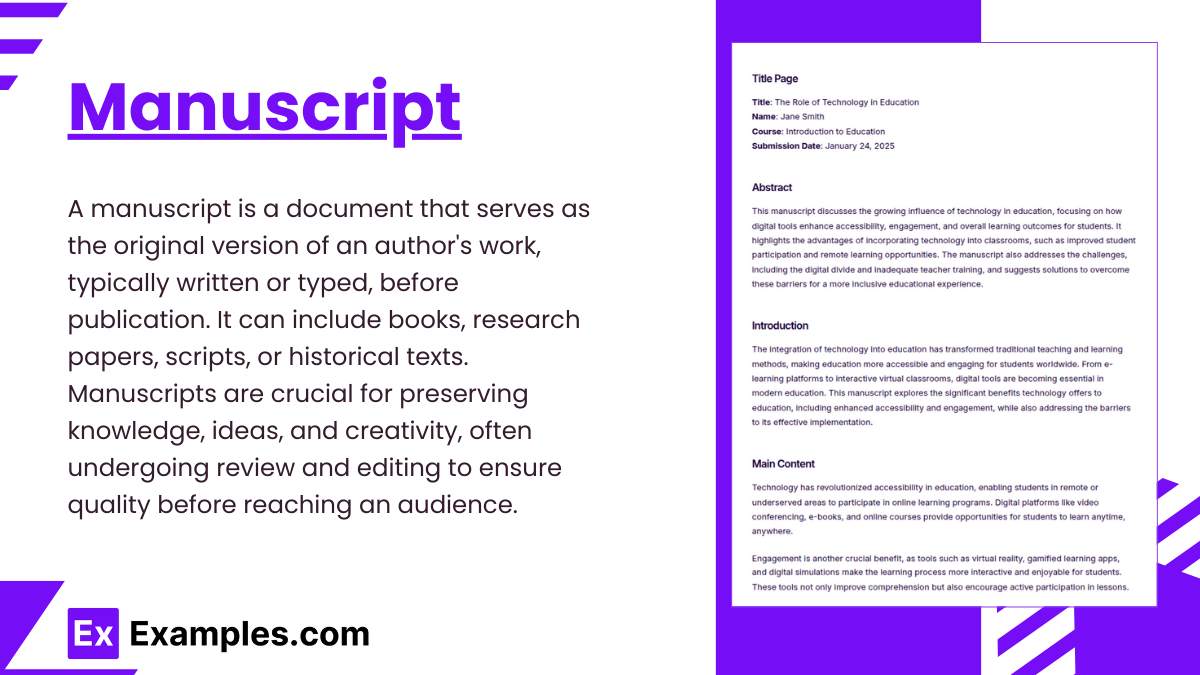11+ Manuscript Examples to Download
A manuscript is a document that serves as the original version of an author’s work, typically written or typed, before publication. It can include books, research papers, scripts, or historical texts. Manuscripts are crucial for preserving knowledge, ideas, and creativity, often undergoing review and editing to ensure quality before reaching an audience. Whether in physical or digital form, they represent the foundation of all written works.
What is Manuscript?
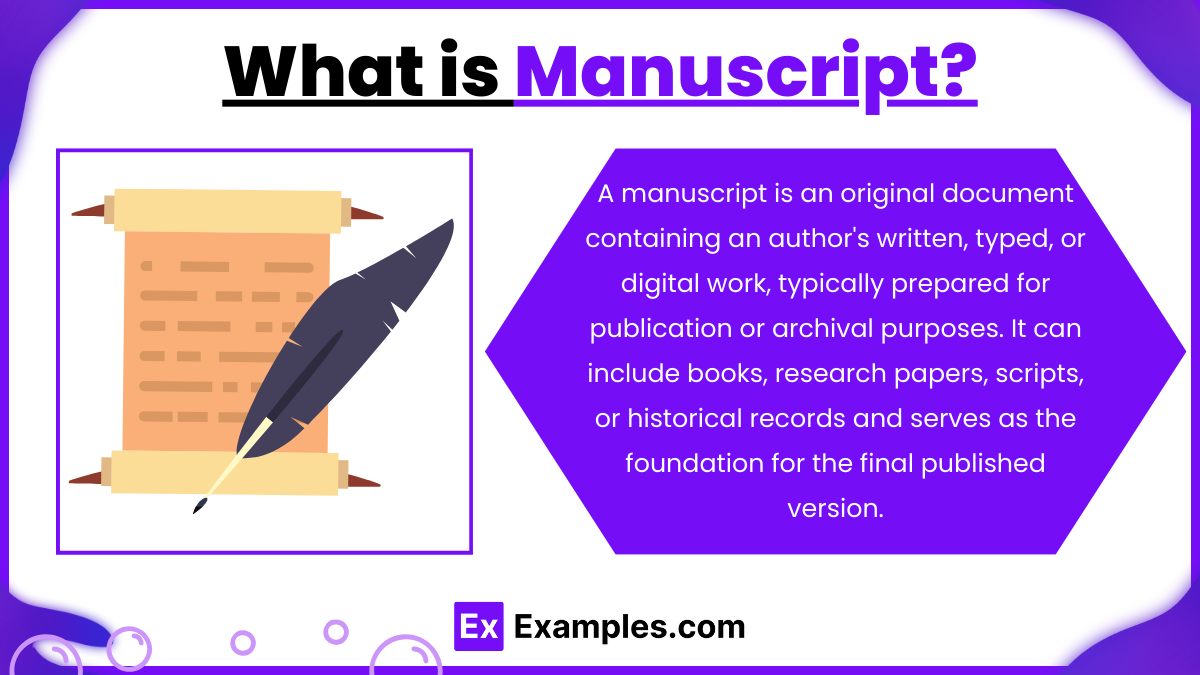
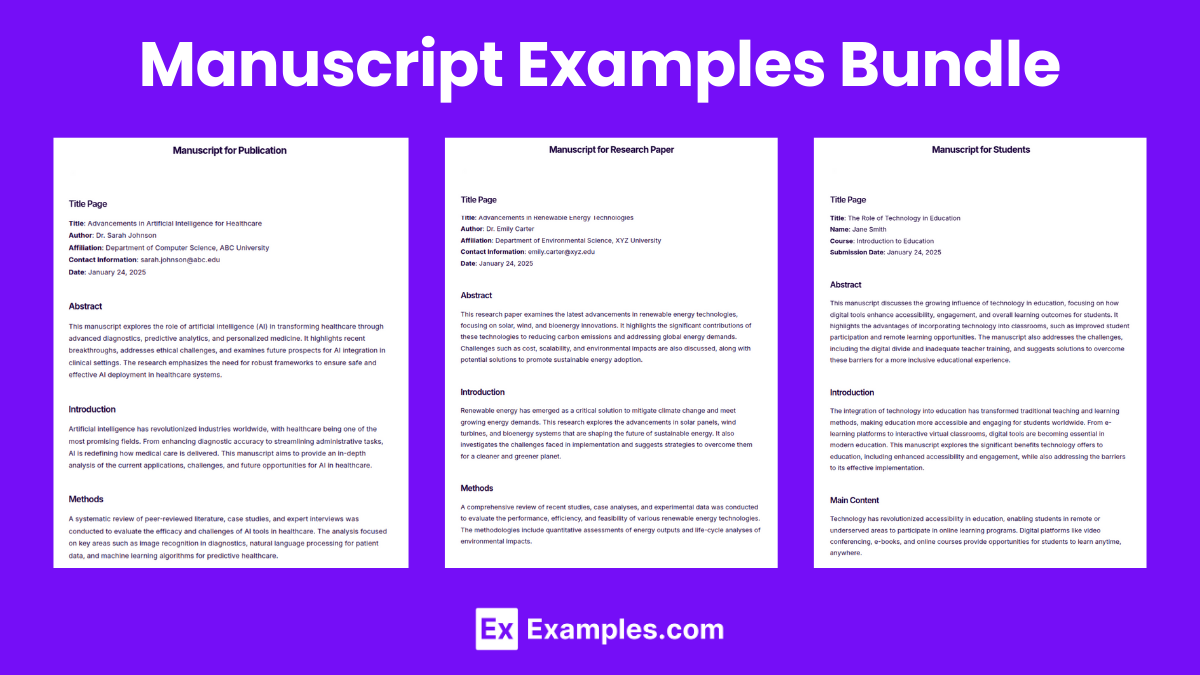
Manuscript Format
Title Page
Include the title of the manuscript, author’s name, affiliation, contact details, and date of submission.
Abstract
Provide a concise summary of the manuscript, highlighting the main points, findings, or objectives.
Introduction
Introduce the topic, background, and purpose of the manuscript clearly and succinctly.
Main Body
Organize the content into sections and subsections based on the subject matter, using appropriate headings.
Conclusion
Summarize the key findings, insights, or takeaways from the manuscript.
References
List all sources cited in the manuscript in the required citation format.
Appendix (if needed)
Include additional materials like tables, charts, or supplementary data.
Manuscript Example
Title: The Impact of Technology on Education
Author: John Doe
Affiliation: XYZ University
Contact Information: johndoe@email.comDate: January 24, 2025
This manuscript explores how technology has transformed education, enhancing learning experiences through innovative tools and platforms. It examines the benefits, challenges, and future trends of integrating technology into educational systems.
Technology has revolutionized various sectors, and education is no exception. This manuscript discusses the role of technology in reshaping traditional learning methods, focusing on accessibility, engagement, and outcomes.
Technology enables remote learning, bridging gaps for students in underserved regions. Interactive tools like educational apps and virtual reality enhance student participation. However, the digital divide and lack of training for educators remain significant barriers.
Technology offers immense potential to improve education, but addressing challenges like accessibility and teacher readiness is essential for sustainable progress.
Smith, A. (2023). Technology in Modern Classrooms.
Johnson, B. (2022). Education and Innovation: A Global Perspective.
Table 1: Statistics on technology adoption in schools globally.
Manuscript Examples
Manuscript for Students
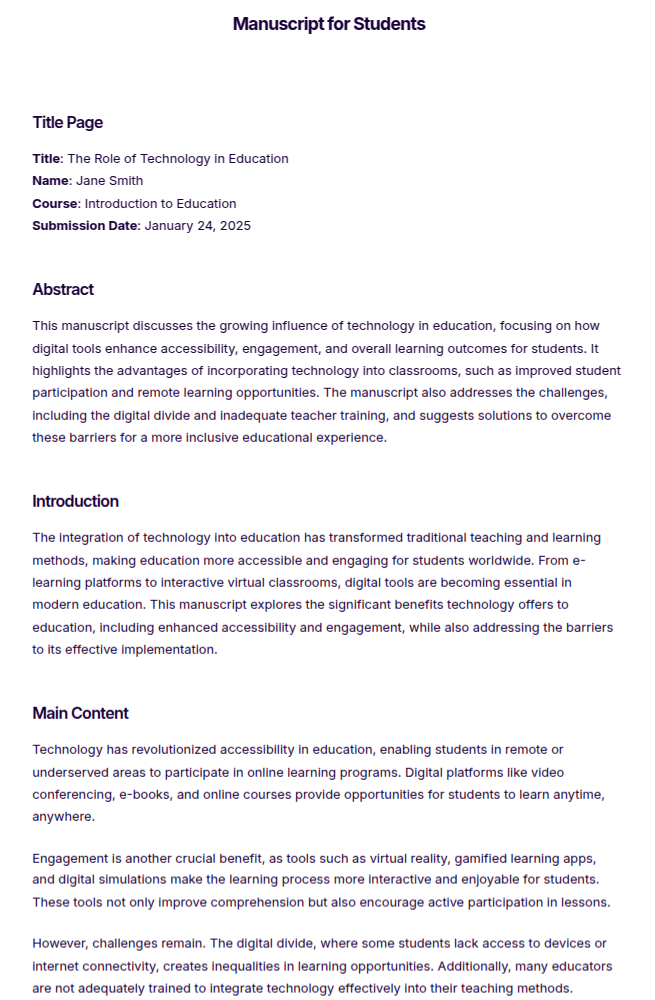
Manuscript for Research Paper
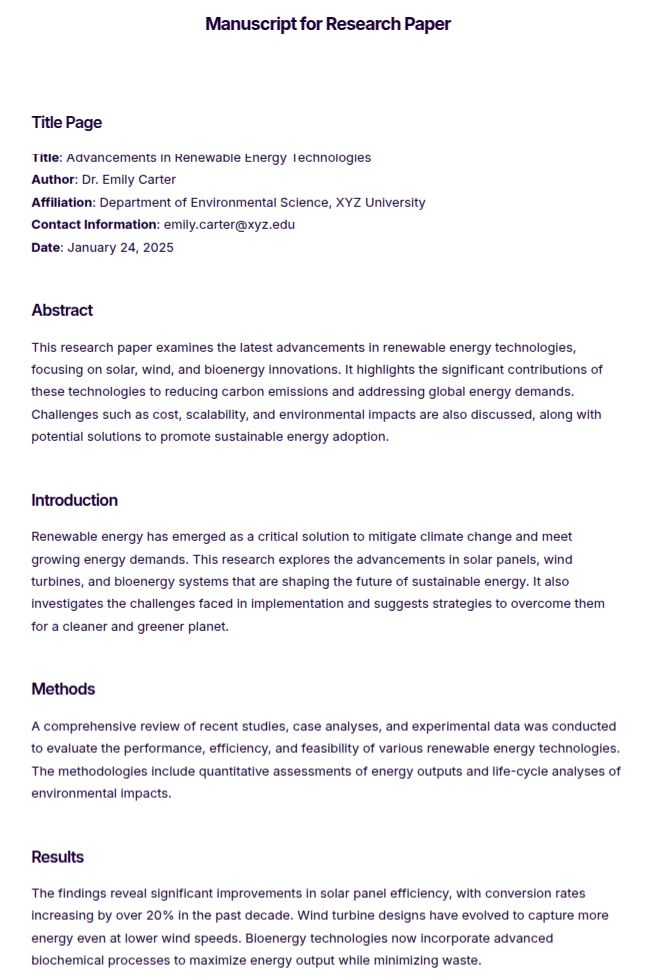
Manuscript for Publication

More Examples on Manuscript
- Manuscript for Journal
- Manuscript for Thesis
- Manuscript for Article
- Manuscript for Speech
- Manuscript for Reporting
Manuscript Book
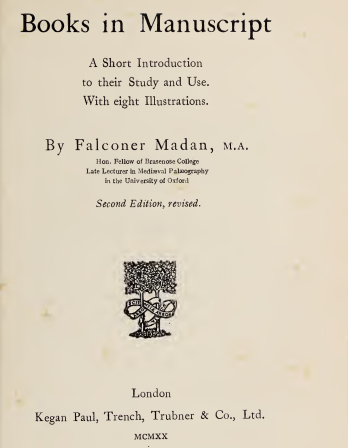
Examples of Manuscript in a Sentence
- The author submitted her manuscript to the publisher, hoping it would be accepted for publication.
- After months of research, he finally completed the first draft of his thesis manuscript.
- The ancient manuscript found in the monastery contained invaluable historical information.
- She carefully formatted the manuscript according to the journal’s submission guidelines.
- The editor suggested several changes to improve the clarity and flow of the manuscript.
- The museum displayed a centuries-old manuscript written on parchment.
- Before submitting the manuscript, the researcher double-checked all the references for accuracy.
- The playwright handed over his manuscript to the director for a new stage production.
- The digital version of the manuscript made it easier to share with peer reviewers.
- His manuscript on renewable energy innovations earned him an award at the science fair.
Examples of Manuscript in Situation
- Academic Research: A Ph.D. student spends months writing a manuscript detailing their findings on climate change impacts and submits it to a peer-reviewed journal for publication.
- Historical Discovery: An archaeologist uncovers an ancient manuscript in a cave, revealing details about a long-lost civilization’s culture and beliefs.
- Publishing a Novel: An aspiring author completes a manuscript for a fantasy novel and sends it to multiple literary agents, hoping for a publishing deal.
- Scientific Breakthrough: A research team writes a manuscript explaining a new medical technique for cancer treatment and presents it at a global conference.
- Screenwriting: A scriptwriter submits their manuscript for a TV pilot to a production house, hoping it gets picked up for filming.
- Restoration Work: A historian works on restoring a fragile manuscript from the 15th century to preserve its contents for future generations.
- Journal Submission: A biologist writes a manuscript on their latest study of marine ecosystems and submits it to a journal specializing in environmental sciences.
- Class Project: A group of college students creates a manuscript for a research project about the evolution of artificial intelligence in daily life.
- Memoir Writing: A retired war veteran writes a manuscript recounting their personal experiences and hardships during service.
- Grant Proposal: A scientist writes a manuscript outlining their research proposal on renewable energy solutions to apply for government funding.
Examples of Manuscript in Oral Communication
- During a lecture, the professor referred to a historical manuscript to explain ancient trade practices.
- A speaker at a conference said, “The ideas in this presentation are based on my recently completed manuscript.”
- The author mentioned in an interview, “I’ve just finished my manuscript, and it’s now with the editor for review.”
- At a book launch event, the writer shared, “This novel started as a simple manuscript I wrote during the lockdown.”
- During a team meeting, the researcher announced, “We’ll submit the manuscript for peer review by the end of this week.”
- A presenter explained, “The manuscript for our findings on renewable energy is available for those interested in further reading.”
- The student told her advisor, “I’ve made the changes you suggested in my thesis manuscript.”
- A historian in a documentary explained, “This ancient manuscript reveals details about medieval society that were previously unknown.”
- In a writing workshop, the instructor said, “The manuscript you draft today will be the foundation for your final story.”
- At a literary festival, the author remarked, “When I first wrote the manuscript, I never imagined it would turn into an award-winning book.”
Types of Manuscript
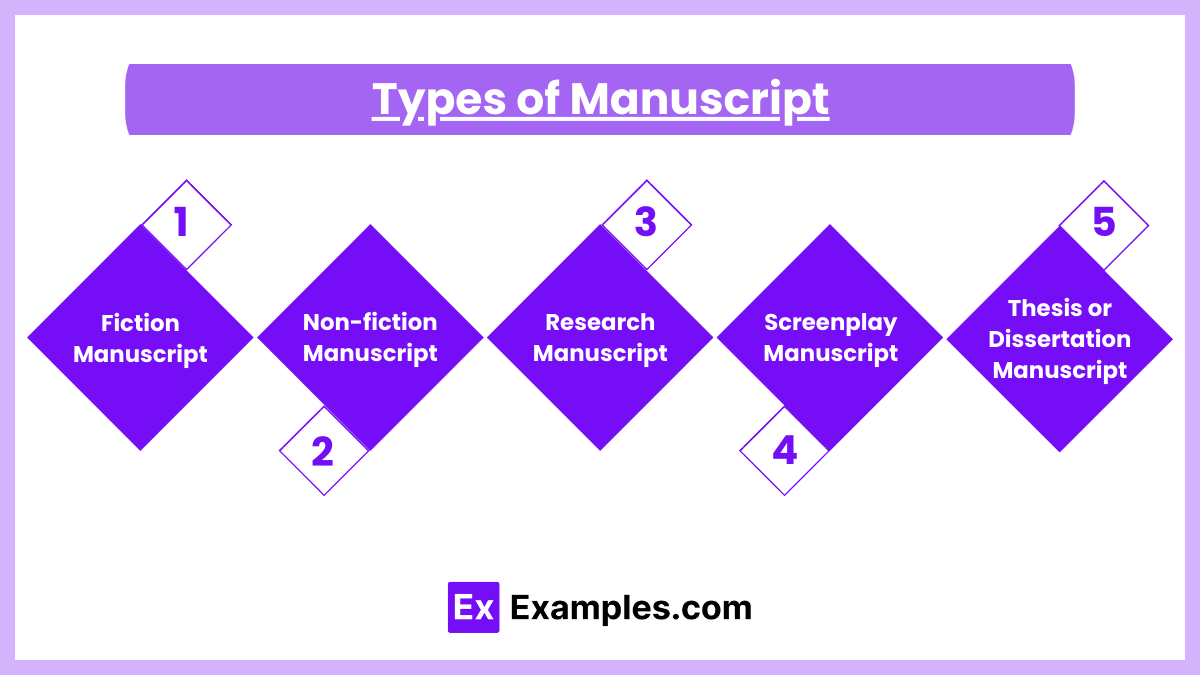
1. Fiction Manuscript
A manuscript written for a novel, short story, or other fictional works, focusing on creative writing and storytelling.
2. Non-fiction Manuscript
This manuscript includes factual content such as biographies, memoirs, essays, or academic papers.
3. Research Manuscript
Typically used in academic or scientific contexts, this manuscript reports research findings and is often submitted to journals for peer review.
4. Screenplay Manuscript
A manuscript specifically written for film or television, following specific formatting rules for dialogue, scene descriptions, and transitions.
5. Thesis or Dissertation Manuscript
A detailed research manuscript that is part of academic requirements, typically for a degree, documenting original research and analysis.
How to Write a Manuscript for Your Story
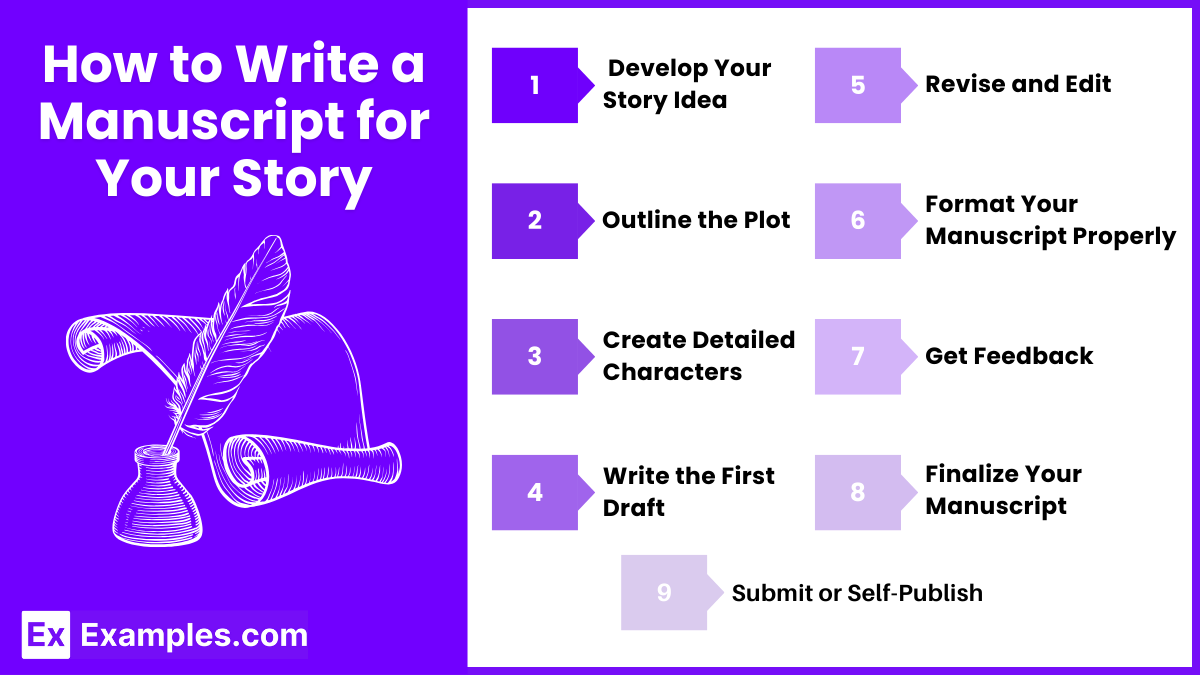
1. Develop Your Story Idea
Start with a compelling idea. Think about your story’s central theme, characters, and the main conflict. Ask yourself: What message do I want to convey?
2. Outline the Plot
Create a clear structure for your story. Divide it into three main parts:
- Beginning: Introduce the characters, setting, and conflict.
- Middle: Develop the story through challenges, twists, and growth.
- End: Resolve the conflict and provide closure.
3. Create Detailed Characters
Build relatable, well-rounded characters with distinct personalities, motivations, and goals. Their actions and development should drive the story forward.
4. Write the First Draft
Start writing without overthinking. Focus on getting your ideas onto the page rather than aiming for perfection. Let the story flow naturally.
5. Revise and Edit
After completing the first draft, revise the manuscript. Look for plot holes, inconsistencies, or unnecessary details. Strengthen your dialogue, pacing, and character arcs.
6. Format Your Manuscript Properly
Use standard manuscript formatting:
- Font: Times New Roman or Arial, 12-point size.
- Spacing: Double-spaced with 1-inch margins.
- Header: Include your name, the title, and page numbers.
7. Get Feedback
Share your manuscript with trusted readers, such as beta readers, writing groups, or mentors. Take their constructive feedback into account to improve your story.
8. Finalize Your Manuscript
Incorporate edits, polish the language, and proofread for grammar, spelling, and punctuation errors. Ensure it aligns with submission guidelines if you plan to publish.
9. Submit or Self-Publish
If submitting to agents or publishers, prepare a query letter and follow their submission guidelines. Alternatively, explore self-publishing options to share your story with the world.
How to Create a Manuscript
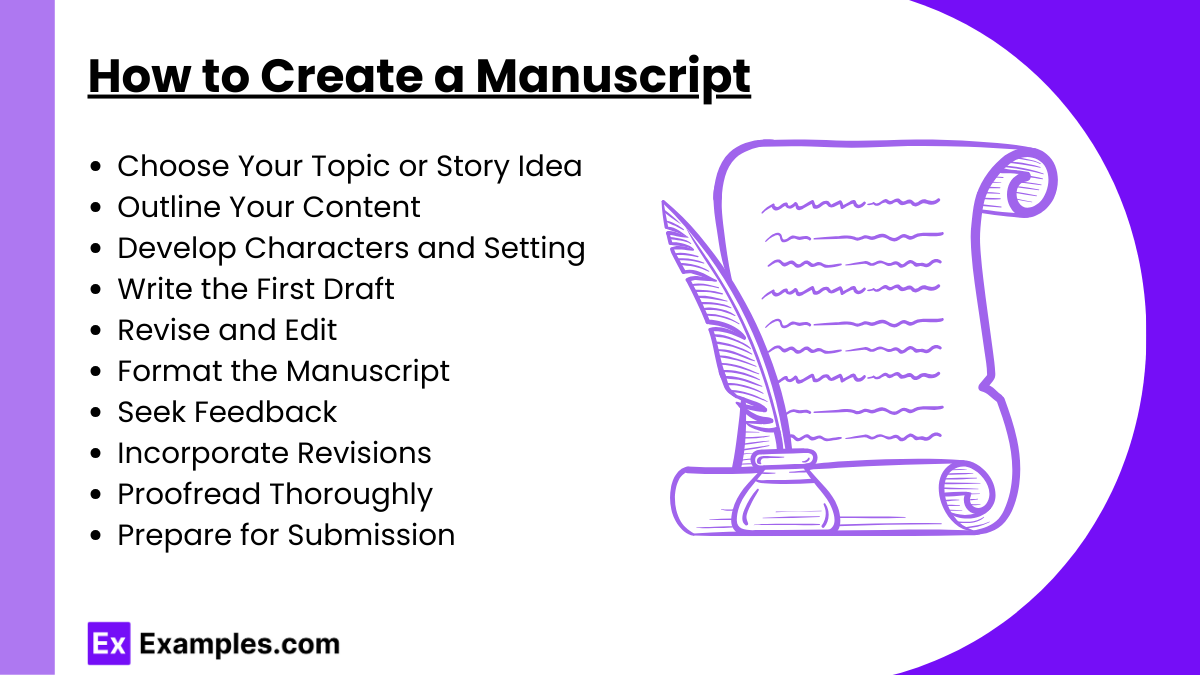
- Choose Your Topic or Story Idea
Decide on the subject, theme, or storyline for your manuscript. - Outline Your Content
Plan the structure of your manuscript with an introduction, main content, and conclusion. - Develop Characters and Setting (for Fiction)
Create detailed profiles for your characters and describe the world they live in. - Write the First Draft
Begin writing your manuscript without worrying about perfection. Focus on getting your ideas down. - Revise and Edit
Review your manuscript for clarity, coherence, and structure. Edit for grammar, punctuation, and style. - Format the Manuscript
Use standard formatting:- Font: Times New Roman or Arial, size 12
- Double-spacing
- 1-inch margins on all sides
- Header with name, title, and page numbers
- Seek Feedback
Share your manuscript with trusted readers or a writing group for constructive criticism. - Incorporate Revisions
Make necessary changes based on feedback to refine your manuscript. - Proofread Thoroughly
Check for spelling, grammar, and formatting errors before finalizing. - Prepare for Submission or Publishing
If submitting to agents or publishers, follow their specific guidelines. For self-publishing, format the manuscript for the chosen platform.
Guidelines of Manuscript
- Formatting
- Use a standard font like Times New Roman or Arial, 12-point size.
- Double-space the text with 1-inch margins on all sides.
- Include page numbers in the top right corner.
- Align the text to the left and avoid full justification.
- Title Page
- Include the title of the manuscript, your name, and contact information.
- If submitting for a journal or publication, follow their specific title page guidelines.
- Abstract
- Provide a concise summary of the manuscript’s main points, including purpose, methods, and conclusions (for academic and research manuscripts).
- Headings and Subheadings
- Use headings and subheadings to organize the content logically.
- Format them consistently throughout the manuscript.
- Citations and References
- Follow the citation style (e.g., APA, MLA, Chicago) as required by the publisher or institution.
- Include a reference list or bibliography at the end of the manuscript.
- Introduction
- Provide background information and a clear statement of the problem or research question.
- For fiction, introduce the main characters and the plot setting.
- Body Content
- Maintain clear, concise language and well-organized paragraphs.
- Use transitions between sections to ensure a smooth flow.
- Conclusion
- Summarize key findings or outcomes.
- For fiction, wrap up the plot and resolve any conflicts or questions raised in the story.
- Editing and Proofreading
- Review the manuscript multiple times for clarity, grammar, spelling, and consistency.
- Consider seeking feedback from peers or editors before final submission.
- Submission Guidelines
- Follow the publisher or institution’s submission guidelines, including file type, length, and any other specific requirements.
Benefits of Manuscript
- Preserves Ideas
A manuscript captures and organizes your thoughts, ensuring your ideas are documented. - Enhances Clarity
Writing a manuscript helps clarify your message and structure your content logically. - Facilitates Publication
A well-prepared manuscript is the first step in getting published in journals, books, or online. - Improves Writing Skills
The process of writing and revising a manuscript enhances your writing abilities. - Provides a Record
A manuscript serves as a formal record of your work, research, or creative effort for future reference.
Tips for Writing a Manuscript
- Start with a Clear Outline
Plan your manuscript’s structure to maintain focus and flow. - Write Consistently
Set a daily or weekly writing schedule to stay on track. - Focus on Clarity and Simplicity
Use clear, concise language to make your content easy to understand. - Revise and Edit Thoroughly
Revisit your manuscript multiple times to refine and polish it. - Seek Constructive Feedback
Share your work with trusted readers or editors for valuable insights.
FAQs
How Long is a Manuscript?
A manuscript typically ranges from 50,000 to 100,000 words, depending on the genre and purpose.
How to Publish a Manuscript?
Submit your manuscript to literary agents or publishers, or self-publish through platforms like Amazon Kindle Direct Publishing.
What is Another Word for Manuscript Writing?
Another term for manuscript writing is “drafting.”
What is a Manuscript vs Book?
A manuscript is the original, unpublished version of a work, while a book is the final, published version.
What Does the Word Manuscript Literally Mean?
The word “manuscript” literally means “written by hand.”
How Do I Make My Own Manuscript?
Write your content, format it according to guidelines, and revise it thoroughly before submission.
What Not to Do When Writing a Manuscript?
Avoid plagiarism, poor formatting, inconsistent style, and ignoring submission guidelines.
Is a Manuscript a Full Book?
Yes, a manuscript can be a full book, but it is in its unpublished form.
What is the Manuscript of a Paper?
The manuscript of a paper is the original version submitted for publication in an academic journal.
What to Write on the First Page of a Manuscript?
Include the title, author’s name, contact information, and word count on the first page of a manuscript.



